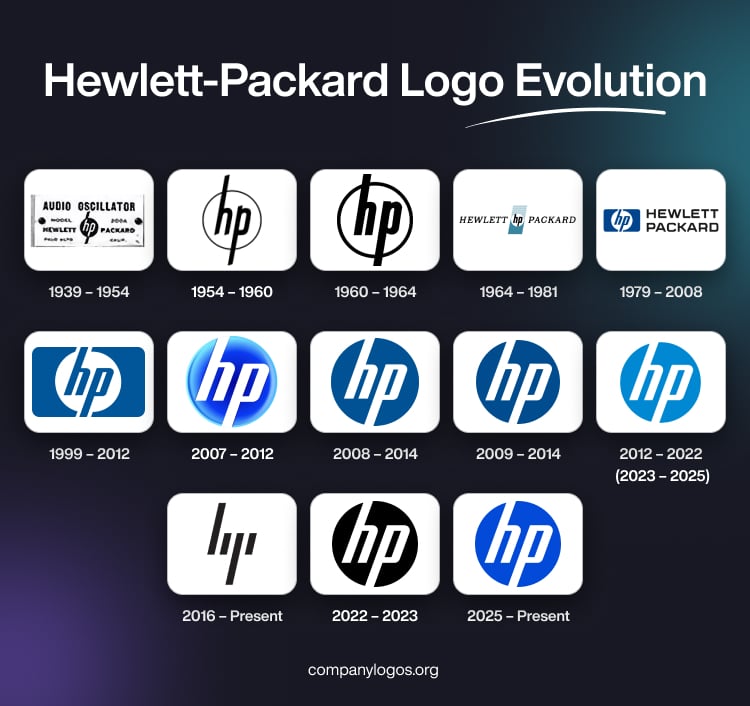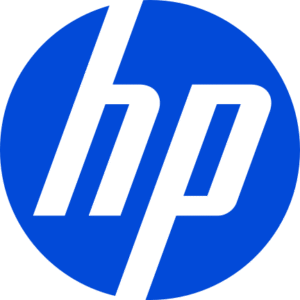
Hewlett-Packard (HP) is a renowned American IT company that has played a significant role in shaping the global tech industry. Founded in 1939, HP has been a pioneer in the technology landscape. Its premier quality products range from computers to printers, other accessories, and software. The identity of HP, or Hewlett-Packard, has evolved alongside its iconic logo.
In fact, the logo reflects the transformation of the company, right from its founding in a garage to its division into two entities. The Hewlett-Packard logo has undergone several transformations over the years. The changes reflect the growth and adaptation of the company to keep up with the changing market dynamics. The article traces the history and evolution of the logo over the years, among other details of the company.
The Genesis of the Hewlett-Packard Logo (1939 – 1954)
The original Hewlett-Packard logo was introduced in 1939. It had a simple yet distinctive design featuring the name of the company in a bold, sans-serif typeface. The letters “hp” in the logo represented the names of the founders: Hewlett and Packard. The logo was rendered in monochrome and displayed white and italicised lowercase letters placed within a black circle. The inscription of Hewlett-Packard was mentioned on either side of the logo in a strong typeface. The logo design was straightforward and represented the company’s no-frills approach to engineering and technology.

(1954 – 1960)
In 1954, Hewlett-Packard saw its first major logo change. The new logo retained the sans-serif typeface but introduced a stylized version of the company’s initials, “HP.” The same was enclosed within a white circle with a thick black outline. This design change marked a shift towards a more modern and recognisable brand identity. The circular emblem represented the company’s commitment to innovation and progress.

(1960 – 1964)
This was a refinement of the previous iteration where the logo elements were made bolder and thicker. Also, the vertical bars of the letters “h” and “p” were made shorter.

(1964 – 1981)
The logo design of the era saw the return of the “Hewlett-Packard” lettering. The emblem comprised a slanted rectangle wherein the letters “HP” were positioned in the middle of a white circle. The additional lettering comprising the founders’ names appeared in an italicised classy serif font.

(1979 – 2008)
In 1979, HP unveiled a new logo that would become iconic in the tech industry. The design featured the initials of the company in a sleek and stylized font. The design saw the seamless merging of letters “h” and “p” together. The colour palette of the logo was a combination of striking blue, white, and black. The lettering consisting of “h” and “p” was painted blue and placed inside a white circle. And on the right side of the white circle, the lettering “Hewlett-Packard” was positioned in two levels and written in a bold sans-serif font. This modernised logo reflected HP’s commitment to cutting-edge technology and design.

(1999 – 2012)
This particular logo redesign was executed by Siegel and Gale Design Bureau. This terse version of the logo consisted of a rectangle with rounded corners with the letters “hp” placed in the middle of a white background.

(2007 – 2012)
Launched on November 15, 2007, this logo iteration featured the circular background in various shades of blue with a gradient, which gave it a 3D effect. Written in a custom Futura typeface, the vertical bars of the letters “h” and “p” were not visible beyond the circular background.

(2008 – 2014)
In 2008, HP introduced another logo update with a more minimalist approach. The new logo had the iconic “HP” initials but came with a simplified design. In fact, it opted for a cleaner and more streamlined look. The green colour was replaced with a deep blue colour to convey a sense of trust and reliability. The logo redesign marked HP’s transition into an era of innovation and adaptation to the ever-evolving tech landscape.

(2009 – 2014)
This logo iteration executed in 2009 had pale blue as the colour of the circle.

(2012 – 2022) (2023 – 2025)
Created by Siegel + Gate, the 2012 logo iteration saw the colour palette of the circular background getting brighter. It embraced a welcoming and more soothing light sky blue colour. The rest of the elements remained untouched.

(2016 – Present)
HP uses this particular logotype in some instances, especially on premium products. Developed by Moving Brands Studio, this logo comprised four oblique black strokes.

(2022 – 2023)
The 2022 logo iteration saw the typeface of the brand name being changed to Forma DJR and the background turned pitch black.

(2025 – Present)
The current HP logo continues to feature the wordmark in a custom Forma DJR typeface, while the circular background is changed to cyan-blue. The colour represents reliability and intellect.

The Elements of the Hewlett-Packard Logo
Symbol
The Hewlett-Packard (HP) logo is a minimalist design that features the initials of the founders of the company represented by the letters’ “H” and “P” in an italicized sans-serif font. The logo is set against a light blue circular background, where the extensions of the letters appear to extend beyond the boundaries of the circle.
Font
The typeface used in the wordmark depicting the HP logo is custom Forma DJR.
Colour
The colour palette of the HP logo has evolved over the years. Initially, it was a simple black-and-white design. However, over the years, it has changed to a deep blue colour palette. Interestingly, the most recent update saw the blue colour being changed to a brighter shade of cyan-blue. At the same time, the wordmark is depicted in white.
The History of Hewlett-Packard or HP
Hewlett-Packard (HP) was founded on January 1, 1939, by Bill Hewlett and David Packard, two electrical engineering graduates of Stanford University. The company began operations in a small garage in Palo Alto, California. It is a site now celebrated as the “Birthplace of Silicon Valley”. With a modest initial investment of $538, Hewlett and Packard developed their first product, the HP 200A. It was a precision audio oscillator used to test sound equipment. This innovative device was known for its stability and affordability. It sold for $54.40 at a time when competitors charged over $200 for less reliable models.
The big break for the company came when Walt Disney Productions purchased eight HP 200B oscillators for use in the production of the 1940 animated film Fantasia. It thus certified the Fantasound surround sound systems in theatres. This early success laid the foundation for HP’s reputation as a maker of sophisticated electronic test and measurement instruments.
HP’s name was determined by a coin toss between the founders, with Bill Hewlett winning the right to have his name first. Throughout the 1940s and 1950s, HP expanded its product line and introduced pioneering management practices. These included open office layouts and profit sharing, which contributed to its reputation as an innovator not just in technology but also in corporate culture.
In the 1960s, HP entered the computer market with the HP 2116A, which was designed to control its test and measurement equipment. The company continued to innovate and developed scientific calculators, computers, and later, printers. By the 1980s, HP offered a full range of computing equipment, from scientific machines to personal computers and peripherals.
HP became the world’s leading PC manufacturer from 2007 until 2013, when Lenovo surpassed it. The company split in 2015 into two entities: HP Inc., which focused on personal computers and printers, and Hewlett Packard Enterprise, which concentrated on business products and services. Throughout its history, HP has been recognized for its contributions to technology, management practices, and the development of Silicon Valley.
Interesting Facts About Hewlett-Packard
- HP was founded by Bill Hewlett and David Packard in 1939 in a car garage in Palo Alto, California. This garage is now a designated historic landmark and is often called the “Birthplace of Silicon Valley”.
- The founders decided the company name, whether Hewlett-Packard or Packard-Hewlett, by flipping a coin.
- HP’s first product was the 200A audio oscillator. Walt Disney Productions bought eight of these for use in the production of the animated film Fantasia (1940).
- HP was ahead of its time in workplace culture. In 1942, it established a pioneering health care plan for employees and used an open floor plan to encourage creativity. In 1973, HP became the first U.S. company to introduce flextime, which allowed employees flexible work hours.
- Founders Bill and Dave started the practice of “Management by Walking Around” in the 1970s. According to this, they personally visited the workspaces of employees to foster communication and collaboration.
- HP introduced several industry firsts. These are as follows:
- The first desktop scientific calculator (1968), which coined the term “personal computer”.
- The world’s first programmable pocket calculator (1974).
- The HP 150 (1983), one of the earliest personal computers with a touchscreen.
- The HP LaserJet (1984), the world’s most popular desktop laser printer.
- In 1964, HP engineers flew around the world with the HP 5060A caesium beam atomic clock to synchronize global atomic clocks to within one-millionth of a second.
- In 1963, HP invented a frequency synthesizer used in deep space vehicles.
- HP was the first tech company to benefit from the close relationship between Stanford University and local industry, which was eventually a key factor in the emergence of Silicon Valley.
- In 2015, HP separated into HP Inc. (personal computers and printers) and Hewlett Packard Enterprise (enterprise products and services).
- Most HP products are now made from recycled plastics, which include ocean-bound plastics.
- HP boasts one of the most diverse boards in the tech industry, with 42% women and 58% minorities.
- HP has acquired over 100 companies. These include major deals like Compaq (2002), Electronic Data Systems (2008), and Palm, Inc. (2010).
- HP holds over 37,000 patents worldwide. These reflect its long-standing emphasis on research and development.
- The open office plan and collaborative management style pioneered by HP have become standard in the tech industry.
- HP established its first international offices in Switzerland and Germany as early as 1959. It was long before many tech companies went global.
Finally
From the simple beginnings of a basic typeface to the modern, minimalist design, the HP logo and its various iterations have carried a distinct identity and meaning. The logo changes have represented the technological advancements of HP as well as its ability to adapt and remain a prominent player in the tech world. The impact of these logo changes on brand identity cannot be overstated. They have become symbolic representations of HP’s values, innovation, and dedication to excellence.